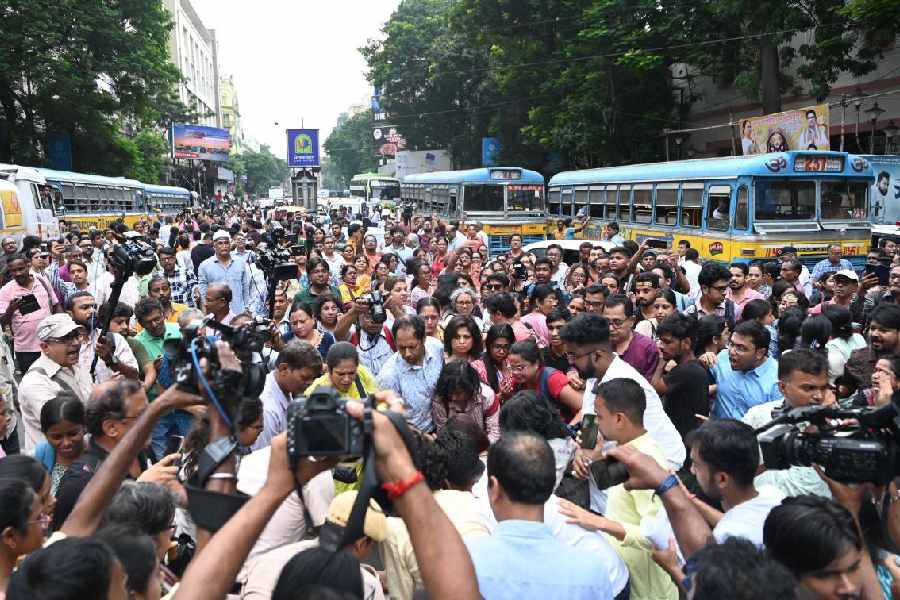A nationwide district-level analysis has consistently shown Mumbai and Alwar among the top 10 districts where rape is reported, with districts from Bengal rarely figuring even in the top 100.
The analysis by the Commonwealth Human Rights Initiative, a non-government entity, and based on statistics from the National Crime Records Bureau (NCRB) between 2015 and 2022, has revealed Mumbai and Alwar as the only districts that appear every year in the top-10 list throughout the study period.
The findings have also revealed clusters of rapes that have taken place repeatedly year after year in the same state, same district, or even same town, patterns that a CHRI analyst said demand a sociological investigation to explore why rapes appear concentrated in the same geography.
The rape and murder of a postgraduate medical student at RG Kar Medical College in August had triggered a nationwide strike by resident doctors and has drawn members of the public to join street protests. It also prompted the Supreme Court to track the case and direct the health ministry to set up a task force to suggest ways to improve safety and working conditions for healthcare workers.
“The data show previously unrecognised geographical patterns in rapes,” said Venkatesh Nayak, CHRI director. “The clusters call for sociological research to understand why such patterns occur and for geographically focussed interventions to substantially reduce the number of rapes,” he told The Telegraph.
Over the eight-year period, for instance, the top 100 among 650 to 700 police districts covered by the analysis accounted for nearly 45 per cent of the country’s total rapes.
Two states — Madhya Pradesh and Rajasthan — have dominated the top 100 districts where rape has been reported between 2015 and 2022, with the two states having the largest count of districts reporting rapes. During 2022, for instance, 32 districts in Rajasthan accounted for 4,807 (15.2 per cent) of the country’s 31,516 rapes, followed by 15 districts in Uttar Pradesh (1,629, 5.1 per cent), and 9 districts in Maharashtra (1,568, 4.9 per cent). Bengal’s 295 rapes from two districts in 2022 accounted for 0.9 per cent of the country’s total.
But over 350 rape-murder cases collectively registered by the police in Kamrup, Latur and Meerut, among other small towns across India over the past five years, have not drawn as much public attention as did the RG Kar case, Nayak said.
“The prominence and public attention that rape-murders occurring in metropolitan cities receive eclipses data which suggests that many small towns across the country are equally, if not even more, dangerous to women,” Nayak said.
Multiple rape-murders have occurred in Kamrup, Assam, for instance, in four of the five years between 2018 and 2022.
In 2021, Kamrup reported 34 rape-murders. Latur in Maharashtra recorded 13 rape-murders in 2019. During 2022, according to the NCRB data, Meerut had the highest count of rape-murders (18), followed by Mathura (17); Chhindwara, Madhya Pradesh (13); Bongaigaon, Assam (12); Morbi, Gujarat (5); and Shahdol, Madhya Pradesh (5).
“This analysis throws up questions — for example, why do rape-murders occur year after year in Kamrup or Alwar?” Nayak said. “These findings call for research into the preventive and punitive measures in place in each such geography where we see clusters of rapes.”
The CHRI in a note on the findings has said preventive measures should focus on boys and men. “To the best of our knowledge, preventive measures make girls and women carry the burden of preventing such crimes — be it through self-defence skills or IT-enabled tracking services,” the CHRI said.
“There are hardly any measures to prevent or remedy the predatory behaviour of those who commit such crimes,” it added.
Designing such measures will require sociological and psychological analysis of the factors that cause such predatory behaviour, the CHRI said.










